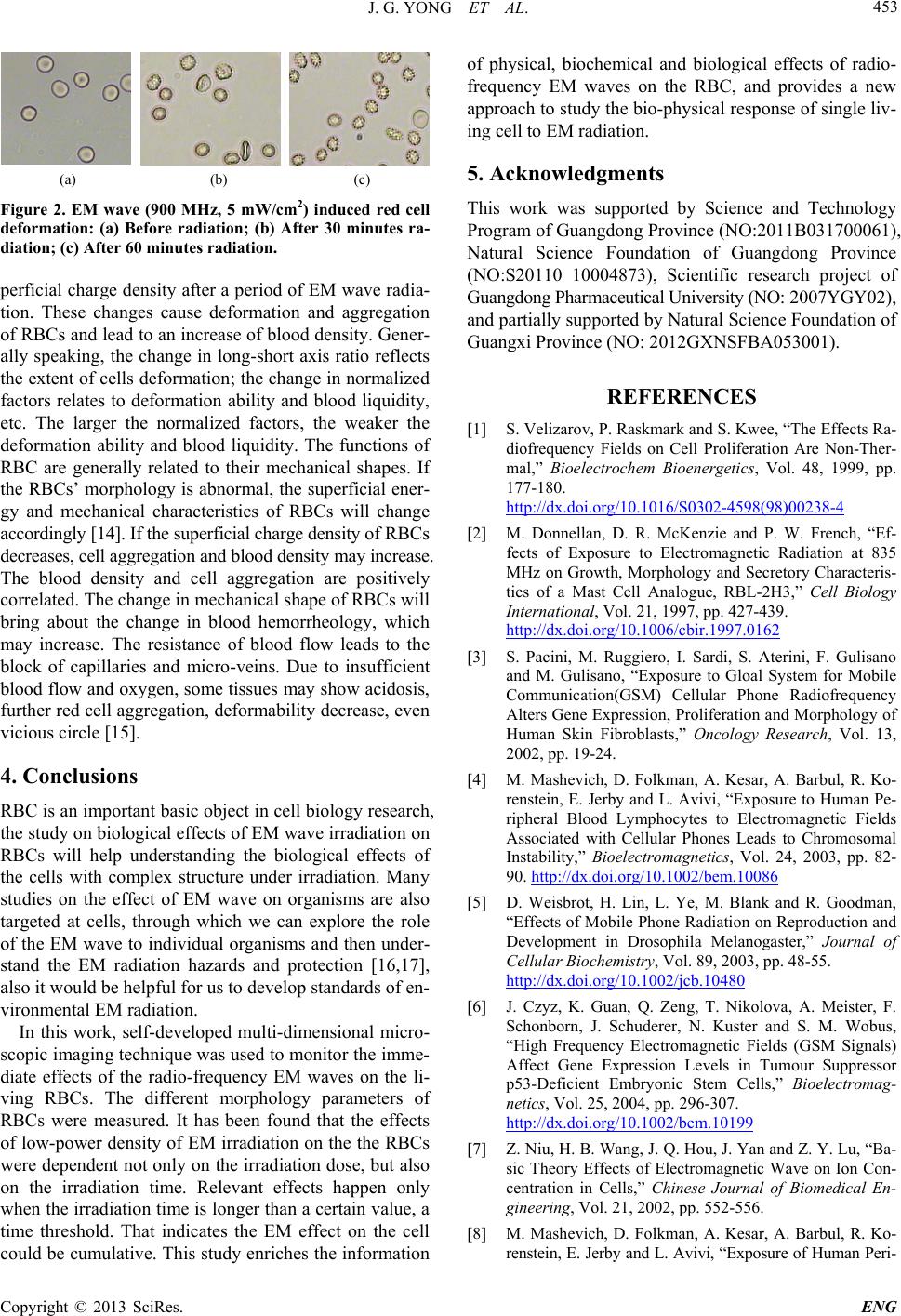
J. G. YONG ET AL.
Copyright © 2013 SciRes. ENG
453
(a) (b) (c)
Figure 2. EM wave (900 MHz, 5 mW/cm2) induced red cell
deformation: (a) Before radiation; (b) After 30 minutes ra-
diation; (c) After 60 minutes radiation.
perf icial ch arge dens ity after a p eriod of EM w ave radi a-
tion. These changes cause deformation and aggregation
of RBCs and lead to a n increase of blood den sity. Gene r-
ally speaking, the change in long-short axis ratio reflects
the extent of cells deformation; the change in normalized
factors relates to deformation ability and blood liquidity,
etc. The larger the normalized factors, the weaker the
deformation ability and blood liquidity. The functions of
RBC are generally related to their mechanical shapes. If
the RBCs’ morphology is abnormal, th e superficial ener-
gy and mechanical characteristics of RBCs will change
accordingly [14]. If the superficial charge density of RBCs
decreases, cell aggregation and blood density may increase.
The blood density and cell aggregation are positively
correlated. The change in mechanical shape of RBCs will
bring about the change in blood hemorrheology, which
may increase. The resistance of blood flow leads to the
block of capillaries and micro-veins. Due to insufficient
blood flow and oxygen, some tissues may show acidosis,
further red cell aggregation, deformability decrease, even
vicious circle [15].
4. Conclusions
RBC is an important b asic object in cell biology r esearch,
the study on biological effects of EM wave irradiation on
RBCs will help understanding the biological effects of
the cells with complex structure under irradiation. Many
studies on the effect of EM wave on organisms are also
targeted at cells, through which we can explore the role
of the EM wave to individual organisms and then under-
stand the EM radiation hazards and protection [16,17],
also it would be helpful for us to develop standards of en-
vironmental EM radiation.
In this work, self-developed multi-dimensional micro-
scopic imaging technique was used to monitor the imme-
diate effects of the radio-frequency EM waves on the li-
ving RBCs. The different morphology parameters of
RBCs were measured. It has been found that the effects
of low-power density of EM irradiation on the the RBCs
wer e dependent not only on the irradiation dose, but also
on the irradiation time. Relevant effects happen only
when the irradiation time is longer than a certain value, a
time threshold. That indicates the EM effect on the cell
could be cumulative. This study enriches the information
of physical, biochemical and biological effects of radio-
frequency EM waves on the RBC, and provides a new
approach to study the bio-physical response of s ingle liv-
ing cell to EM radiation.
5. Acknowledgments
This work was supported by Science and Technology
Program of Guan gdo ng Prov inc e ( NO:2011B031700061),
Natural Science Foundation of Guangdong Province
(NO:S20110 10004873), Scientific research project of
Guangdong Pharmaceutical University (NO: 2007YGY02),
and partially supported by Natural Science Foundation of
Guangxi P rovince ( N O: 2012GXNSFBA053001).
REFERENCES
[1] S. Velizarov, P. Raskmark and S. Kwee, “The Effects Ra-
diofrequency Fields on Cell Proliferation Are Non-Ther-
mal,” Bioelectrochem Bioenergetics, Vol. 48, 1999, pp.
177-180.
http://dx.doi.org/10.1016/S0302-4598(98)00238-4
[2] M. Donnellan, D. R. McKenzie and P. W. French, “Ef-
fects of Exposure to Electromagnetic Radiation at 835
MHz on Growth, Morphology and Secretory Characteris-
tics of a Mast Cell Analogue, RBL-2H3,” Cell Biology
International, Vol. 21, 1997, pp. 427-439.
http://dx.doi.org/10.1006/cbir.1997.0162
[3] S. Pacini, M. Ruggiero, I. Sardi, S. Aterini, F. Gulisano
and M. Gulisano, “Exposure to Gloal System for Mobile
Communication(GSM) Cellular Phone Radiofrequency
Alters Gene Expression, Proliferation and Morphology of
Human Skin Fibroblasts,” Oncology Research, Vol. 13,
2002, pp. 19-24.
[4] M. Mashevich, D. Folkman, A. Kesar, A. Barbul, R. Ko-
renstein, E. Jerby and L. Avivi, “Exposure to Human Pe-
ripheral Blood Lymphocytes to Electromagnetic Fields
Associated with Cellular Phones Leads to Chromosomal
Instability,” Bioelectromagnetics, Vol. 24, 2003, pp. 82-
90. http://dx.doi.org/10.1002/bem.10086
[5] D. Weisbrot, H. Lin, L. Ye, M. Blank and R. Goodman,
“Effects of Mobile Phone Radiation on Reproduction and
Development in Drosophila Melanogaster,” Journal of
Cellular Biochem is try, Vol. 89, 2003, pp. 48-55.
http://dx.doi.org/10.1002/jcb.10480
[6] J. Czyz, K. Gua n, Q. Zeng, T. Nikolova, A. Meister, F.
Schonborn, J. Schuderer, N. Kuster and S. M. Wobus,
“High Frequency Electromagnetic Fields (GSM Signals)
Affect Gene Expression Levels in Tumour Suppressor
p53-Deficient Embryonic Stem Cells,” Bioelectromag-
netics, Vol. 25, 2004, pp. 296-307.
http://dx.doi.org/10.1002/bem.10199
[7] Z. Niu, H. B. Wa ng, J. Q. Hou, J. Yan and Z. Y. Lu, “Ba-
sic Theory Effects of Electromagnetic Wave on Ion Con-
centration in Cells,” Chinese Journal of Biomedical En-
gineering, Vol. 21, 2002, pp. 552-556.
[8] M. Mashevich, D. Folkman, A. Kesar, A. Barbul, R. Ko-
renstein, E. Jerby and L. Avivi, “Exposure of Human Peri -